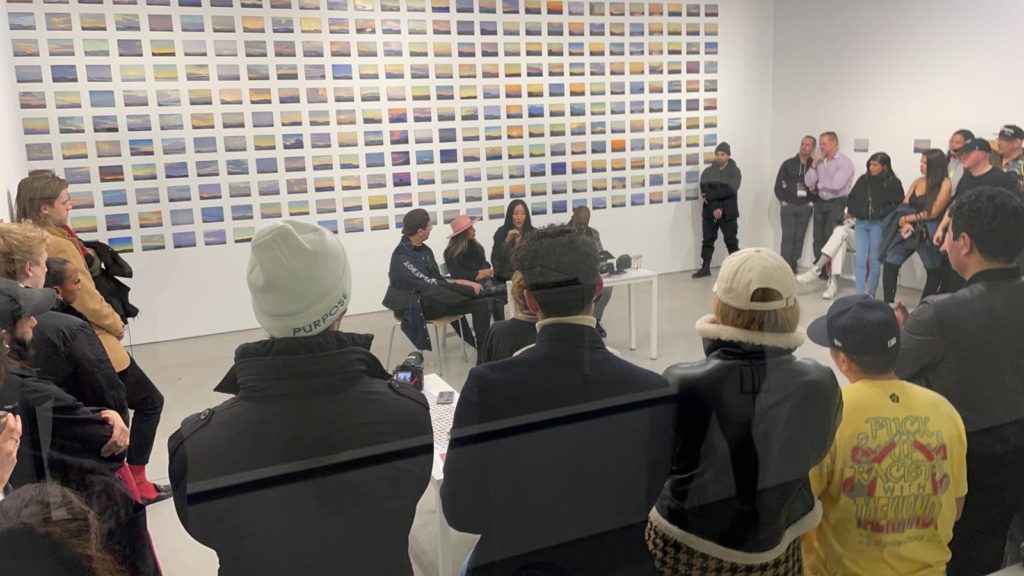The last few months in the NFT space have been a whirlwind of high-profile auctions, international conferences, and social impact initiatives. While many metaverse conversations at the beginning of the year took place on Discord, Telegram, and in late-night Clubhouse rooms – NFTs and the ecosystem around them are now being discussed IRL on a larger scale than ever before.
One place where non-fungible conversations are now the norm is Lisbon. The capital of Portugal has rapidly become an epicentre of the “crypto revolution,” hosting the Ethereum conference, Nearcon, Solana Breakpoint, and Web Summit within just a few weeks. The fact that Lisbon’s main bridge is nearly identical to San Francisco’s Golden Gate Bridge somehow makes this moment feel like more than a mere coincidence.
The next evolution of NFTs will drive communities founded on the value of abundance, not scarcity ✨ @WillPapper @lililashka @pplpleasr1 @santiagoroel @0xliscon pic.twitter.com/XHtEwJXfdC
— shann.eth 🎨✨🛸 (@shanvasion) October 21, 2021
After this year’s Liscon, it’s clear that NFTs are here to stay, with more than a half-day of programming dedicated explicitly to NFTs and the Creator Economy. In fact, many of the key points and predictions covered during the fall Ethereum conference were seen on display in real-time at NFT.NYC – and are continuing to play out as the NFT ecosystem continues to grow. Here are four important takeaways, from my perspective, from attending both Liscon and NFT NYC:
Gamification will play a significant role in NFT and crypto adoption
The future of games is intertwined with technology at this point, and many are predicting that gamification will play a central role in the mass adoption of crypto. Token-based games were not only a topic of conversation on the Liscon panels but also played out in real-time throughout the conference. Barcelona-based Witnet hosted an on-site conference game playing on the concept of rarity in NFT collections. Attendees were given an egg that they could incubate by scanning the QR code of other conference attendees. The more times that an egg was incubated, the rarer the traits of the attached NFT became. The excitement amongst conference-goers showed how games function as perfect incentives to build community while simultaneously serving as icebreakers.
But it’s play-to-earn games that will drive crypto adoption, especially in emerging markets. The NFT-based online video game Axie Infinity continues to trailblaze in play-to-earn gaming and is (at the time of writing) the most googled NFT collection of 2021. Made by a Vietnamese video game studio and co-founded by WTF DAO member Jiho, Axie Infinity has seen rapid growth in emerging nations such as the Philippines, where people playing crypto games earn weekly wages significantly higher than the local minimum wage.
<blockquote class=”twitter-tweet”><p lang=”en” dir=”ltr”>Sustainability of the Axie economy is very important!<br><br>We just updated our WhitePaper to make sure our thinking around this subject is crystal clear 🤝<br><br>👉 <a href=”https://t.co/22cBC8ZtF7″>https://t.co/22cBC8ZtF7</a> <a href=”https://t.co/0ECUWJvgMt”>pic.twitter.com/0ECUWJvgMt</a></p>— Axie Infinity🦇🔊 (@AxieInfinity) <a href=”https://twitter.com/AxieInfinity/status/1460319955124109313?ref_src=twsrc%5Etfw”>November 15, 2021</a></blockquote> <script async src=”https://platform.twitter.com/widgets.js” charset=”utf-8″></script>
DAO so hot right now
Decentralized Autonomous Organizations are popping up everywhere, from the Howard University DAO to the MidsummerDAO, which focuses on community-owned storytelling production + distribution. DAOs are buying and fractionalizing “Doge” memes and making bids on copies of the US Constitution. There are even DAOs creating dinner clubs centred around NFTs.
GET SOME $WAGMI 🔋 GET SOME $WAGMI 🔋 GET SOME $WAGMI https://t.co/7PQSDYCEYX
— MidsummerDAO (🎬, 🎬) (@MidsummerDAO) October 30, 2021
We continue to see how DAO’s allow a group of passionate people to unite around a specific cause or and action and simultaneously raise capital. While everything doesn’t need to be an NFT in the same way that not everything needs to be a DAO, it’s clear that this new form of governance is only beginning to catch mainstream attention. While DAO’s have many benefits, they can also slow down decision-making and potentially struggle with an uneven balance of power due to voting structures. However, they are still a relatively new concept, and as they evolve, initiatives such as The Daoist will help to provide resources for those looking to gain a deeper understanding and also champion decentralized governance.
Utility is key in high-volume NFT projects.
NFTs are proving to be more than a jpeg, with projects starting to showcase the prolonged utility that comes with holding an NFT. During NFT.NYC, many of the parties were geared towards specific communities and holders of NFTs from these projects. For example, On1Force, Ethereals, and Frogland joined forces for their B00N1LAND party, which required guests to own assets from at least one of these projects to enter.
<blockquote class=”twitter-tweet”><p lang=”en” dir=”ltr”>NFT fam after BOON1LAND <a href=”https://twitter.com/Etherealswtf?ref_src=twsrc%5Etfw”>@Etherealswtf</a> event last night! <a href=”https://twitter.com/hashtag/NFTNYC?src=hash&ref_src=twsrc%5Etfw”>#NFTNYC</a> <a href=”https://t.co/n9kVN2bVE5″>pic.twitter.com/n9kVN2bVE5</a></p>— Ciara ☾ Nicole (@MoonlightCiara) <a href=”https://twitter.com/MoonlightCiara/status/1455642550434517004?ref_src=twsrc%5Etfw”>November 2, 2021</a></blockquote> <script async src=”https://platform.twitter.com/widgets.js” charset=”utf-8″></script>
Emerging ticketing platform TicketFairy, also announced a new Web3 integration, allowing for tickets to be issued based on specific contract addresses. While this feature is still under development, it’s clear that we will see more and more in the coming months.
Utility can present itself in many different ways. From unlockable content to exclusive access to NFT airdrops, adding additional value can help NFT projects expand their reach while further building community.
On Tuesday evening we launched our brand new NFT functionality at the world’s first NFT token-gated event in New York.
The immersive audio-visual experience where NFTs, technology and music collide was hosted by @Monstercat and https://t.co/RtoucwkTdL. pic.twitter.com/YGkRLag0Dx
— TICKETFAIRY® (@TicketFairy) November 5, 2021
NFTs for Social Good
The ability to build social impact directly into smart contracts has created a movement towards NFT projects that also provide additional resources and support for the general public. Gitcoin, which is dedicated to growing and sustaining open source software, has recently begun its own NFT project, which is dedicated to helping solve coordination failures in Human Society. We recently talked to Gitcoin CEO Kevin Owocki about the project, which includes an alternate-reality coordination game called The Greatest Larp.
More about the recent NFT Gitcoin project from CEO Kevin Owocki:
Kevin: The project is inspired by the Meditations on Moloch essay from Scott Alexander, which discusses the coordination failures in human society that exist because of a lack of coordination mechanisms in society. The theory is that if humans were more rational, they would shift systems, but it becomes difficult to achieve because they can’t coordinate-
Gitcoin has created a series of comic books around fighting Moloch. If we can slay Moloch, we can create more coordination in the world. We want to build a metaverse where every DAO is fighting moloch.
🔔@Gitcoin NFT auction is LIVE NOW! 👉https://t.co/PmXfqkgD7g
⚔️Grab a friend and join THE GREATEST LARP
✨New Anon vs Moloch comic, #NFT Auctions
💞Funds go directly to the Gitcoin Matching Pool pic.twitter.com/YIkKjg4O5p
— Gitcoin Vibes (🤖, ❤️) (@GitcoinDAO) October 20, 2021
What do you see for the future of NFTs?
Kevin: NFTs have accomplished a lot, meaning at the very least, art has a business model. Are NFTs a bubble, or has art been undervalued? They have the opportunity to solve systemic problems that nation-states could not solve. What if we could solve public goods funding?
100% of proceeds from the sale of NFTs centered around The Greatest Larp go to fund
the Gitcoin Grants Matching Pool, which funds public goods on Gitcoin Grants.



